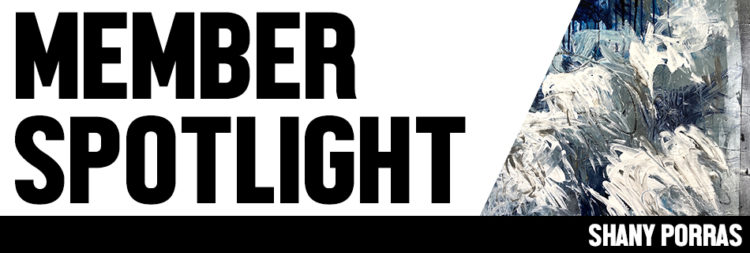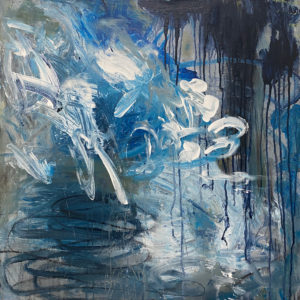
Shany Porras
About | Shany Porras’s abstract paintings visually translate what one experiences through music. She started studying classical music when you, which has meant that music remains an essential part of her daily living. She ‘sees’ music as an abstract language, and she translates music to paintings, much in the same way she would translate one language to another. Shany chooses music that is inspirational to her, selecting topics such as Greek mythology, her home country of Venezuela, or today’s popular or politically charged music. Each painting is unique to each musical piece. It is clear that her selection of mediums, including acrylic paint, graphite, wax crayons, ink, and spray paint, found objects, etc. hinges on her interpretation of the language of music. Her art is deeply influenced by Bauhaus and the American abstract painters of the 20th century, borrowing from their techniques and applying them as needed to interpret music.
Shany Porras has a B.A. and a B.F.A. from Rice University in Houston, Texas. At Rice, Shany started as an architecture major, then transferred into the Fine Art program after her sophomore year. She focused on painting and lithography, establishing a foundation of abstract art. Shany’s paintings have been selected into juried shows such as the Connecticut Academy of Fine Art’s annual juried exhibition and Fountain Street Gallery’s annual call for art. Shany currently maintains a studio outside Boston, MA, and actively shows in both New England and New York City. Shany is an associate member of the National Association of Women Artists (NAWA) and Cambridge Art Association (CAA).
Q & A
What are your earliest memories of being artistic? I’ve been artistic since my earliest childhood memories. I always know that visual and performing art made me happy.
When did art become a pursuit? I pursued visual arts and music in high school and college. Then I took a 20+ year detour and worked in corporate America after I failed to get into a reputable art gallery right after college. I took it as a sign that I should get a “real job.” Looking back, I wish I had had mentors around me to push me on with the arts, but regardless, I do not dislike where I’ve ended up!
Are you self-taught or formally educated in visual art? I received my B.F.A. from Rice University in Houston, so I am formally trained.

Translation No. 2 of Sonata No. 1 for Cello and Piano in D Minor (Claude Debussy), Acrylic and graphite on canvas
How did you first become involved with CAA? I’ve always admired the artists and art that CAA exhibits. I find it an honor to be part of this long standing arts association and add to its story.
In what other ways are you involved in the local art community? I currently show with Fountain Street Gallery; another organization that I’ve always admired. I am also a member at NAWA. I am currently working on establishing a new studio in Pittsfield, Massachusetts, and am currently getting to know that arts community.
What role do you think the artist plays in society? I find that it is an artist’s responsibility to be honest and authentic, no matter what the means. I can’t help but want to include political symbols and stories in my current artwork, for instance, this is all I think about these days. The challenge for me is to tie music to experience. Each artist needs to put out the questions that cannot or will not be answered.
What medium do you currently work in and how did you choose this medium? I am an acrylic painter. I was originally an oil painter, but the fumes from the solvents made me ill. So I had to switch to acrylics.
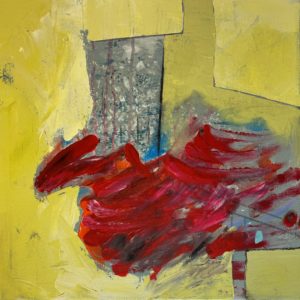
Translation No. 1 of Symphony No. 1 (The Conflict), Acrylic on canvas
What is your creative process? Where are you finding ideas for your art these days? I focus on music as inspiration. I’ve always been very visually stimulated by music, so I find it an easy topic to paint. I also enjoy learning more deeply about the history of the music and the writers or composers.
How do you choose your subject matter? Is there a reoccurring theme that carries throughout your work? I translate music into abstract paintings. What I find interesting is how each musical piece I study and then translate, manifests itself into a unique painting.
In your opinion, what’s your best/favorite piece you’ve made? I really like how “Stay or Leave” turned out. It felt like an honest and raw translation of the song by Dave Matthews.
What is one of your artistic goals? I am striving to get to “the one” piece that I would not dare show anyone.
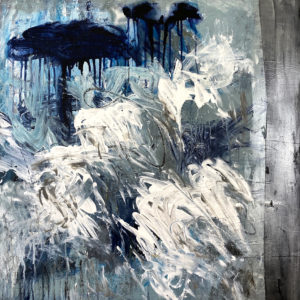
Translation No. 1 of Sonata No. 1 for Cello and Piano in D Minor (Claude Debussy), Acrylic and graphite on canvas
What’s your favorite place to see art, and why? I am partial to the Menil Collection in Houston. I grew up artistically in that museum as I fell in love with Cy Twombly, Ad Reinhardt, Ellsworth Kelly, Willem de Kooning, and many others. I also would spend afternoons drawing the sculptures in their art of Americas halls. Being inside the Renzo Piano-designed building was always a calming and reassuring experience for me; as if all is good in the world because there is art.
What living artists are you inspired by? I am a follower of Sterling Ruby, Howardena Pindell, and Jenny Saville. They inspire me to search for the truth in my art. I am also inspired by local, abstract artist Judith Schneider. Her art touches me more than she will ever know.
Do you own any art by other artists? Is so, what artists? Yes, I collect some art, but not enough…I actually have a de Kooning, which leveled me when I happened to get it at an auction. I have a Georges Rouault. I also collect art at fairs and local shows. I feel the need to collect working and emerging artists’ art that moves me.
Do you have any shows coming up? I am currently at the Brookline Art Center’s Open Studios with several pieces that translate music by Marin Marais and Mozart. I also show online at www.1stDibs.com through Fountain Street Gallery.
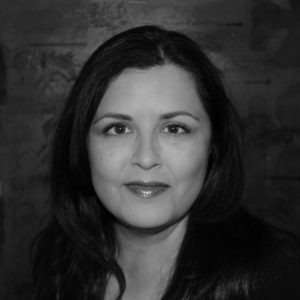
See more from Shany
Website: www.number5studios.com
Instagram: @number5studios
Facebook: Number 5 Studios
